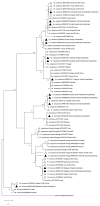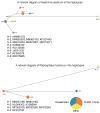Genetic Diversity of Hard Ticks (Acari: Ixodidae) in the South and East Regions of Kazakhstan and Northwestern China
- PMID: 33684994
- PMCID: PMC7939963
- DOI: 10.3347/kjp.2021.59.1.103
Genetic Diversity of Hard Ticks (Acari: Ixodidae) in the South and East Regions of Kazakhstan and Northwestern China
Abstract
To date, there is no report on the genetic diversity of ticks in these regions. A total of 370 representative ticks from the south and east regions of Kazakhstan (SERK) and Xinjiang Uygur Autonomous Region (XUAR) were selected for molecular comparison. A fragment of the mitochondrial cytochrome c oxidase subunit I (cox1) gene, ranging from 631 bp to 889 bp, was used to analyze genetic diversity among these ticks. Phylogenetic analyses indicated 7 tick species including Hyalomma asiaticum, Hyalomma detritum, Hyalomma anatolicum, Dermacentor marginatus, Rhipicephalus sanguineus, Rhipicephalus turanicus and Haemaphysalis erinacei from the SERK clustered together with conspecific ticks from the XUAR. The network diagram of haplotypes showed that i) Hy. asiaticum from Almaty and Kyzylorda Oblasts together with that from Yuli County of XUAR constituted haplogroup H-2, and the lineage from Chimkent City of South Kazakhstan was newly evolved; and ii) the R. turanicus ticks sampled in Israel, Almaty, South Kazakhstan, Usu City, Ulugqat and Baicheng Counties of XUAR were derivated from an old lineage in Alataw City of XUAR. These findings indicate that: i) Hy. asiaticum, R. turanicus and Ha. erinacei shared genetic similarities between the SERK and XUAR; and ii) Hy. marginatum and D. reticulatus show differences in their evolution.
Keywords: Genetic diversity; Kazakhstan; hard tick; northwestern China.
Conflict of interest statement
The authors declare that they have no conflict of interest.
Figures


Similar articles
-
Application of DNA barcodes in the genetic diversity of hard ticks (Acari: Ixodidae) in Kazakhstan.Exp Appl Acarol. 2024 Apr;92(3):547-554. doi: 10.1007/s10493-023-00893-1. Epub 2024 Feb 22. Exp Appl Acarol. 2024. PMID: 38386133 Free PMC article.
-
Tick distribution in border regions of Northwestern China.Ticks Tick Borne Dis. 2019 Apr;10(3):665-669. doi: 10.1016/j.ttbdis.2019.02.011. Epub 2019 Feb 26. Ticks Tick Borne Dis. 2019. PMID: 30833199
-
Molecular detection of tick-borne pathogens harbored by ticks collected from livestock in the Xinjiang Uygur Autonomous Region, China.Ticks Tick Borne Dis. 2020 Sep;11(5):101478. doi: 10.1016/j.ttbdis.2020.101478. Epub 2020 Jun 2. Ticks Tick Borne Dis. 2020. PMID: 32723638
-
A broad-range survey of ticks from livestock in Northern Xinjiang: changes in tick distribution and the isolation of Borrelia burgdorferi sensu stricto.Parasit Vectors. 2015 Sep 4;8:449. doi: 10.1186/s13071-015-1021-0. Parasit Vectors. 2015. PMID: 26337627 Free PMC article.
-
Distribution and ecology of ticks (Acari: Ixodidae) infesting livestock in Tunisia: an overview of eighth years field collections.Parassitologia. 1999 Sep;41 Suppl 1:5-10. Parassitologia. 1999. PMID: 11071534 Review.
Cited by
-
Population genetic structure and demographic history of Dermacentor marginatus Sulzer, 1776 in Anatolia.Sci Rep. 2025 Apr 12;15(1):12570. doi: 10.1038/s41598-025-97658-0. Sci Rep. 2025. PMID: 40221486 Free PMC article.
-
East-to-west dispersal of bird-associated ixodid ticks in the northern Palaearctic: Review of already reported tick species according to longitudinal migratory avian hosts and first evidence on the genetic connectedness of Ixodes apronophorus between Siberia and Europe.Curr Res Parasitol Vector Borne Dis. 2024 Jul 14;6:100201. doi: 10.1016/j.crpvbd.2024.100201. eCollection 2024. Curr Res Parasitol Vector Borne Dis. 2024. PMID: 39188549 Free PMC article.
References
-
- Cherednichenko A. Estimating agricultural adaptation to climate change through cloud activation for northern Kazakhstan. In: Qi J, Evered KT, editors. Environmental Problems of Central Asia and Their Economic, Social and Security Impacts. Tashkent, Uzbekistan: Springer; 2008. pp. 183–190. - DOI
-
- Yamanaka H, Murata K, Tabata R, Kawaguchi F, Sasazaki S, Yamamoto Y, Bakhtin M, Kazymbet P, Meldevekob A, Suleimenov MZ, Nishibori M, Mannen H. Kazakhstani Native Cattle Reveal Highly Divergent mtDNA From Bos Taurus and Bos Indicus Lineages With an Absence of Bos Indicus Y Chromosome. Anim Sci J. 2019;90:29–34. doi: 10.1111/asj.13128. - DOI - PubMed
-
- Bismil’din FB, Shapieva ZZ, Anpilova EN. Current malaria situation in the Republic of Kazakhstan. Med Parazitol (Mosk) 2001;181:24–33. (in Russian). - PubMed
-
- Zhou M, Cao S, Sevinc F, Sevinc M, Ceylan O, Moumouni PF, Jirapattharasate C, Liu M, Wang G, Iguchi A, Vudriko P, Suzuki H, Xuan X. Molecular detection and genetic identification of Babesia bigemina, Theileria annulata, Theileria orientalis and Anaplasma marginale in Turkey. Ticks Tick Borne Dis. 2016;7:126–134. doi: 10.1016/j.ttbdis.2015.09.008. - DOI - PubMed
-
- Mihailovich SS, Isaevna MG. Land border delimitation of Republic of Kazakhstan: practical knowledge of border policy formation. Eur Sci Rev. 2018;2018:202–204. doi: 10.29013/ESR-18-7.8-202-204. - DOI
MeSH terms
Substances
Grants and funding
- 2018ZX10101002-007/National Key Research & Development Program of China
- 2018ZX10101002-003/National Key Research & Development Program of China
- 81960379/National Natural Science Foundation of China
- 31960709/National Natural Science Foundation of China
- 18YJCZH220/Humanities and Social Sciences Research Projects
LinkOut - more resources
Full Text Sources
Other Literature Sources

